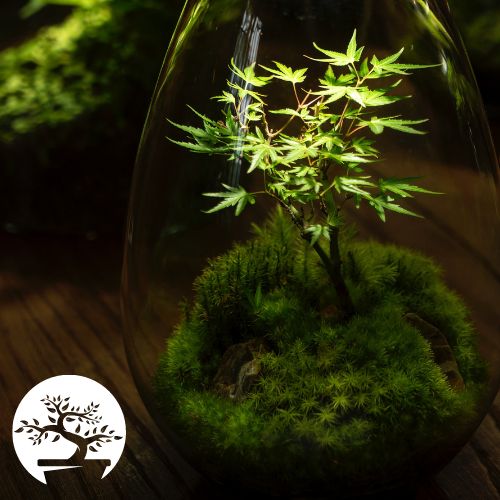Growing moss on bonsai trees can be a great way of improving the appearance and health of the trees.
However, it can be challenging to know where to start if you’ve never cultivated bonsai moss before. In reality, growing moss is a super easy and enjoyable process.
Why Growing Moss On Bonsai Trees is a good idea
Most people want to add moss to their bonsai tree to boost its aesthetic value. Although bonsai moss certainly looks great, that’s not the only reason to cultivate it. It also prevents plant dehydration and protects the roots of the tree.
And luckily, moss growing is one of the most straightforward bonsai processes for plant owners. Once the moss has been installed at the base of the tree, it can take care of itself without much trouble.
Growing Moss On Bonsai Trees: A 4 Step Guide
Growing moss is a fairly straightforward process that all bonsai enthusiasts can quickly master. Here’s a quick step-by-step guide for adding a layer of beautiful moss to the base of your bonsai tree.
Step 1: Collect a moss specimen
Of course, the first thing you need to do to start growing bonsai moss is to collect some existing moss. Moss is a ubiquitous plant that grows everywhere. So if you look around outside your home, you’ll likely find an abundance of moss.
Collect enough moss to cover the base of your bonsai tree. Try to harvest the same moss species if possible since this will ensure the growth remains healthy and consistent.
Step 2: Prepare the soil
Before laying down the moss, it’s crucial to prepare the top layer of soil. First, remove any loose debris and trim any aerial roots down to soil level. Using a pair of root scissors is the best way to do this.
Step 3: Lay down a layer of moss
Place a thin layer of moss across the soil at the tree’s base. You don’t have to cover the whole soil layer, but it often looks best if you do.
If you can get your hands on some Sphagnum moss from your local garden center, then you can put this down before your fresh moss layer. Sphagnum moss helps to keep the fresh moss moist and in position.
Step 4: Apply a mist
Finally, apply a generous mist over the moss layer.
Which Types Of Moss Can You Grow On A Bonsai Tree?
There are a few different types of moss that grow well on bonsai trees. The key is to find a moss type that requires the same conditions to grow as your particular tree. Every moss has different soil pH and water requirements, and the same applies to bonsai.
Here are some common moss types that generally pair well with bonsai trees:
- Bryum argenteum
- Atrichum
- Ceratodon
- Thuidium
- Polytrichum
- Hypnum
- Ctenidum.
It’s also important to remember that each moss type provides a different texture and look to the tree’s base. Be sure to look at some pictures of the mosses before deciding which one you want.
Propagating Bonsai Moss For Other Trees
Another cool thing you can do with bonsai moss is propagate it for other trees. There are two main methods you can use to do this: collecting grown moss or using moss spores. Both ways are very quick and easy to do.
Method 1: Collect established moss
This approach is probably the easier of the two. However, an advantage of using established moss is that it has already adjusted to your environment, so you shouldn’t have any trouble growing on another of your bonsai trees.
Collect a small amount of moss from your bonsai tree and allow it to dry for a few days. Once dry enough, crumble the moss into a light dust. Next, thoroughly water the base of your moss-less bonsai and sprinkle the moss dust over the top.
To promote quick and healthy growth, mist the new moss twice a day.
Method 2: Bonsai moss spores
Using moss spores is the best approach if you want a large bank of moss that you can use across multiple bonsai trees. It is possible to harvest the spores, but most people need to buy them separately.
To start your moss nursery, fill up as many plant pots as you need with potting soil. Make sure all the pots have adequate drainage.
Spread the spores throughout the soil, aiming to get an even distribution. Water the pots and then mist them daily to generate a damp environment. It would help if you also placed the pots in the area with the most direct sunlight.
After around a month, your moss should have grown enough to be ready for harvesting. Take the moss from the pots and place it around the base of your bonsai.
Watering A Bonsai Tree With Moss
Watering a bonsai tree shouldn’t change once you introduce moss. With that said, you may have to add water more carefully since it will take longer to soak through the moss and into the soil. In addition, you should regularly mist the moss to keep it green, luscious, and healthy.
Where To Find Moss For Collecting
Collecting bonsai moss is one of the most enjoyable parts of the process. Heading out into nature to hunt down the plant is an enriching and grounding experience. You can often find moss in sunny places such as rooftops, cracks in concrete, and attached to tree bark.
Ideally, you want to collect moss that lives in similar conditions to your bonsai tree. For example, if your tree is in a warm, humid greenhouse, you should look for moss in direct sunlight and near water.
